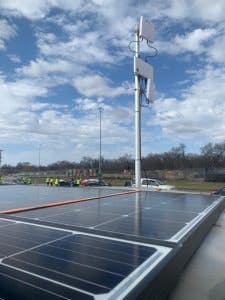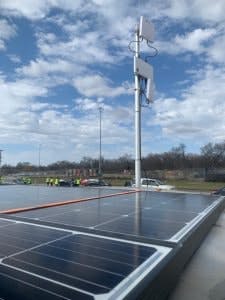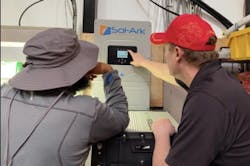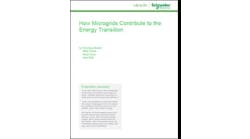It was fortuitous that Oscar Ruiz arrived in Texas on February 19. He had originally intended the trip for another reason, but he quickly became the point person for an on-the-ground mission to build emergency clean energy systems for desperate Texans. Millions had lost power and water as a result of an historic deep freeze.
Solar generator in Texas. Photo courtesy of Footprint Project.
Ruiz is the solar and logistical lead for Footprint Project, an organization that provides emergency clean energy — microgrids, solar and energy storage — to communities in crisis. So he is accustomed to thinking on his feet.
“The limitation is usually finding equipment,” said Ruiz, who is from Puerto Rico and is also executive director of Sail Relief Team, which brings disaster relief to remote and underserved communities. “If we can get people to help, we can get the solar generators out the door. It’s like, ‘Let’s make the project happen.’ ”
Fortunately, Will Heegaard, operations director at Footprint Project, and his associates had been on top of it, making calls to potential equipment donors as soon as it was clear the storm was coming. A shoestring operation, Footprint Project relies on donations and volunteers.
Equipment donations came from SimpliPhi Power, CED Greentech, Sol-Ark Solar and New Use Energy.
Need for remote power
One of the organizations happy to receive the generators was Fayette County. Craig Moreau, a paramedic and chief of emergency management and homeland security for the county, said he’s passionate about replacing emergency power with safer alternatives because he has seen patients maimed and killed by fossil fuel generators.
“After the winter storm, there was a need for remote power to help citizens dealing with a variety of problems. The [Footprint Project] team sent down a solar generator to help us, and I am very grateful. We hope that when the next inevitable disaster strikes we will have more resources like this to deploy to citizens in need,” Moreau said.
Representatives for the companies that donated the equipment were happy to lend a helping hand.
“We work with the Footprint Project because they dedicate their resources to helping people and communities recover from some of the worst climatic catastrophes in the US, when people are vulnerable and without access to reliable power,” said Catherine Von Burg, CEO and president of SimpliPhi Power, which donated 10 of its 3.8-kWh batteries.
The opportunity to help people is also the reason New Use Energy (NUE) donates equipment. “Aside from the obvious environmental and logistical advantages, the human impact of simply using portable solar generators over gasoline generators cannot be more profound. This is what really excites me, personally, about the niche NUE is addressing. We are truly making affordable, portable clean energy accessible when it is needed,” said Stacy Wilde, chief corporate social responsibility officer for NUE.
Emergency clean energy suitcases and trailers
In addition to the batteries, the solar generators included 12 kW of solar. Some were mounted on trailers; others were packaged in “solar suitcases,” basically suitcases that contained the components.
To date, Footprint Project has assembled six portable solar generators in Texas, two of which are on trailers. The generators power communications sites. These are important to emergency response efforts, which can be hampered by fuel logistics challenges, said Heegaard, a former paramedic.
“If your radios don’t work, you can’t do anything,” he said.
Two of the generators are helping power communications trailers that support vaccination sites, Ruiz added.
The equipment will remain in Texas as insurance against power outages. Footprint Project, which owns much of the gear, can monitor some of the larger systems remotely.
An energy recovery strike force
Oscar Ruiz, Courtesy of Footprint Project
Footprint Project is increasingly becoming a presence during humanitarian disasters. The team made it to Iowa within two hours after a derecho, a severe wind storm, left 200,000 people without power last summer. Following the March 2020 tornados in Nashville, the team could be found providing clean energy for community donation and distribution centers. They energized an emergency medical clinic on the US/Mexican border to help asylum seekers during the pandemic. Their volunteers were also among the first to respond to Puerto Rico’s earthquake in January 2020, bringing portable solar generators to the epicenter.
The organization’s rapid response usually begins with the team monitoring weather and the news, searching for humanitarian disasters.
“When there’s a disaster, a power outage, we start keeping tabs immediately and reach out to our partner organizations to find out what they are planning on doing,” said Heegaard. The team forges connections through disaster networks. In the Texas case, Footprint Project contacted the Information Technology Disaster Resource Center. Heegaard and his associates call these organizations to find out who is helping out and where.
“One of the biggest challenges for disasters is coordination: How to get resources in, where should they go, where should they land,” he said.
In Texas, when it became clear the weather was taking a turn for the worse, the Footprint Project program administrator called every solar company in the Houston, Dallas, Austin and San Antonio regions searching for donations of solar or battery systems. “We asked what they had in warehouses, asked for donations and rentals or turnkey systems we could borrow,” said Heegaard. They even looked for do-it-yourself trailers that people stored in their garages. These trailers can be used to transport the generators.
At first, it was unclear how long the power outage would last. But once it became evident that the power would be out for more than 24 hours, the team decided to mount a solar rapid response.
Ruiz’s coincidental trip to Texas helped expedite that response and get help where it was needed as quickly as possible.
“A lot of this is serendipitous,” said Heegaard. “We couldn’t have done this so rapidly without having Oscar scheduled to fly. We would have had to drive. It was luck.”
Footprint Project team working in Texas. Photo courtesy of Footprint Project.
Build back greener
Footprint Project’s work continues, with the team searching for any and all opportunities to “build back greener” after wildfires, hurricanes, floods, storms or other disasters.
“We jump at every single opportunity to mobilize solar generator resources during a disaster to support long term recovery and be available for the next one in that region,” Heegaard said.
Learn about microgrids being built to supply power following disasters. Join us in May for “Microgrids as Reliability Heroes,” a special session during Microgrid 2021, a virtual conference produced by Microgrid Knowledge. Participation is free if you register in advance.











